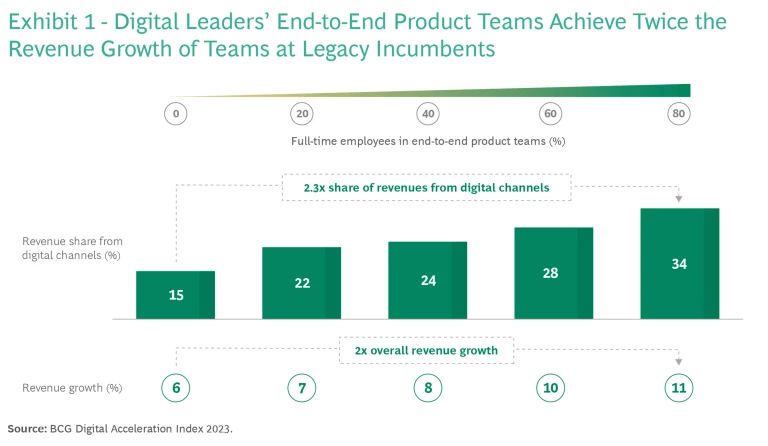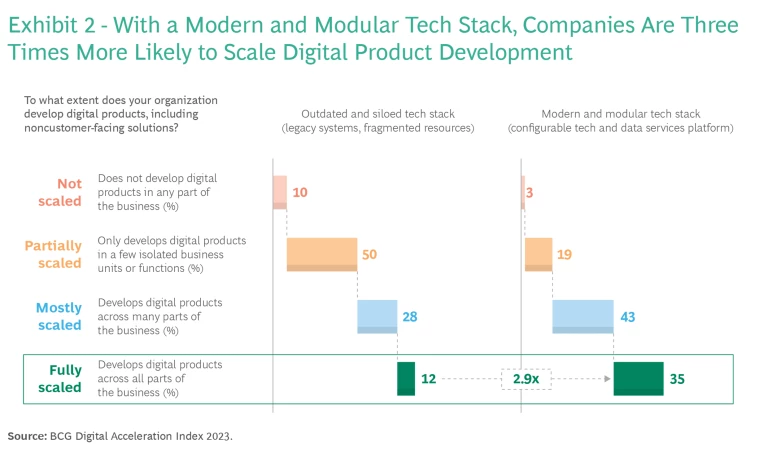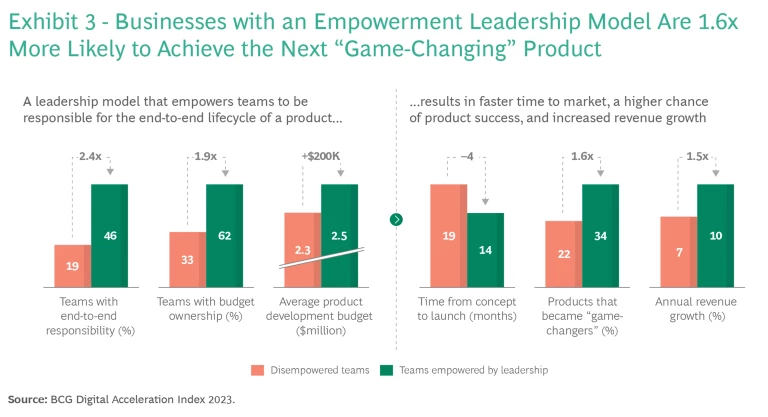Our global, multiyear Digital Acceleration Index (DAI) study reveals that leading digital businesses are innovating at speed. Their operating model contains a learning loop that powers continuous innovation through product teams, digitally powered solutions , and a supportive culture and governance—while retaining the cost efficiency and control elements of conventional models. We call this operating model the “ innovation flywheel .” (See “Inside the Innovation Flywheel.”)
INSIDE THE INNOVATION FLYWHEEL
In contrast, the operating models of a great majority of legacy incumbents actively restrict broad-based experimentation and test-and-learn innovation. The resulting dynamics weaken their ability to keep pace and compete in the digital era. Perhaps unsurprising, 85% of these incumbents admit to a relatively siloed structure; in particular, there is insufficient alignment between the business units and the technology function. They develop and launch 24% of their products without any form of end-user testing, and 44% don’t use customer data during product innovation.
The difference shows. Time to market for digital products is 40% faster from build to market launch for digital champions than for legacy incumbents. They deliver more than twice the number of game-changing digital products and generate nearly three times the total revenue growth. (See “
About the Digital Acceleration Index
.”)
An Operating Model for the AI Age
With the innovation flywheel, four interconnected components help businesses innovate at speed and at scale.
Product Primacy. While businesses in most industries today claim to use end-to-end product teams—including more than 90% of the industrial goods manufacturers in our survey, for example—a closer look at the data reveals that they do not use them at scale. In fact, they allocate just a third of their employees to those teams, on average, while the teams themselves build only half of the organization’s digital products.
To get the flywheel spinning, in contrast, companies need to establish multidisciplinary product teams with full responsibility for the lifecycle of the product and its value stream. In fact, the digital leaders in our study organize all resources, processes, assets, and technologies around their products—recognizing that products are the touchpoints between the business and the customer at which value is created.
These teams sit at the center of the flywheel. The product manager that leads each team is responsible for the product’s dynamic evolution and for helping the team deliver its target results. Such teams unlock tremendous employee potential: multidisciplinary teams achieve 22% more revenues from digital channels and have 23% lower attrition rates than teams with very few functional roles.
We found that truly product-led businesses:
- Deploy twice as many people (in fact, 60% of their organization) in cross-functional product teams as legacy incumbents.
- Dedicate twice as many of their business functions to building digital products.
- Have six times more of their FTEs fully dedicated to digital work, from data scientists to chief digital officers.
- Have four times more of their FTEs using AI solutions on a day-to-day basis.

As a result, they achieve revenue growth that is twice as high as that of legacy incumbents, primarily driven by digital channels. (See Exhibit 1.)
Continuous Innovation. While a flywheel team’s first priority is to invent a breakthrough product, its next priority is to generate ongoing, user-centric innovation around that product. We have identified a common operating playbook that digital leaders follow to generate successive rounds of data-driven innovation. This playbook integrates the foundational approaches of design thinking, lean, and agile.
To implement this playbook, companies should follow four sequential steps.
- First, they should help product teams get to know their customers better by aggregating data so that teams can access it readily and in real time.
- Next, their product teams should use AI to analyze customer data from purchase to service, online user behavior and product reviews, and social media data, extracting insights about what customers like, dislike, and desire from a product. This information can help guide product improvement and development. The digital leaders in our DAI study use AI-generated customer insights 2.3 times more than legacy incumbents.
- Third, businesses should run rigorous, rapid experiments to reveal innovative new solutions and test them.
- Finally, they should build and deploy agile software-development routines and production processes to support the new solutions.
Fluid, Modular Technology. Digital technology , and AI in particular, is the foundation of the four-step playbook, greatly accelerating the speed at which product teams learn, generate new insights, and apply them to create value for the end user. To be successful, businesses therefore need to create a fluid, modular, and flexible technology environment—one in which access to data, microservices, and expertise lets teams move quickly and creatively.

Using a modern and modular tech stack, companies can shorten their time from product concept to launch by more than five months. In addition, leaders in modularity are three times more likely to scale digital product development across multiple functional areas than are those still struggling with outdated, legacy systems. About 80% of the digital leaders in our survey have already set up their organizations in this way, versus only 15% of legacy incumbents. (See Exhibit 2.)
Empowerment Leadership-and-Governance Model. Flywheel teams should be truly independent. Businesses can accomplish this by pushing decision-making authority downward and outward, creating autonomous, multidisciplinary teams that are focused on a single issue or initiative. They should then empower these teams to decide the best way to fulfill their missions and give them the skills, roles, and resources to do so. In this way, the flywheel model targets a root structural issue: the complex web of interdependencies that underlies most of the challenges facing traditional governance models. Among our findings on leadership and governance:

- Three quarters of leading digital businesses say that their governance model maximizes team empowerment.
- Twice as many of their teams have end-to-end responsibility for product and business outcomes as do the teams at legacy incumbents, and the majority of teams have full budget ownership.
- The model also increases the chances of building the next “game-changing” product by 60%. Game-changing products are ones that radically transform the business and provide significant commercial value. (See Exhibit 3.)
- And companies with an empowerment leadership model tend to go bold—trusting their teams with an average $200,000 more budget per product. These investments pay off with 50% greater revenue growth per year.
While this approach isn’t appropriate for every company, the principles are useful guideposts for any incumbent organization looking to evolve. Each company’s unique contextual circumstances, including leadership, culture, talent, and technological orientation, will dictate how best to apply these elements.
A New Transformation Pathway
Thousands of companies over the past decade have launched full-scale digital transformation initiatives, most of which have proven notoriously difficult to pull off. In fact, a separate BCG study found that nearly 76% of digital transformation initiatives fail to achieve their stated objectives.
The flywheel approach offers an alternative path. Its transformative potential extends to every critical element of the enterprise, including culture and talent, organizational design, ways of working, and technology. To get started, organizations should follow three practical guidelines.
Start small (but think big). Transformation efforts typically kick off big, bold programs with fanfare and a heavy investment. Companies should start instead by picking one problem—a point of customer friction or operational inefficiency, for example—with obvious potential for unlocking value. They should then assemble a multidisciplinary flywheel team and task it with solving the problem in a novel way. They should also empower its members to follow the playbook, clearing the runway for the team to build and launch a product and create business impact as quickly as possible.
Demonstrate value to leadership. Flywheel teams must build something useful quickly and get it into the hands of users so the team can get feedback, adjust, and make improvements. The leadership should therefore give flywheel teams a license to start testing their concepts with customers immediately. This creates two sources of momentum: the team can quickly demonstrate business impact, and the leadership can witness and support the success of the flywheel model.
Build on success to scale across the organization. The pilot product team can serve as proof of the flywheel concept. Once the value is understood, leaders can empower other flywheel teams to build products based on the same approach. And they can build management systems, reporting mechanisms, and a portfolio of technology services to support the flywheel. In this way, the first team accelerates organizational learning about what works and helps eliminate the barriers to scaling the flywheel operating model across the entire enterprise.
ABOUT THE DIGITAL ACCELERATION INDEX
The authors would like to thank Marc Roman Franke and Patrick Laske for their valuable contributions to this article.












